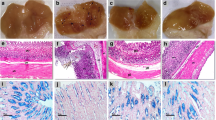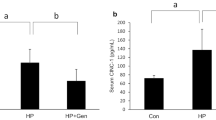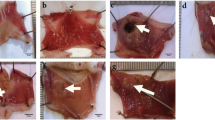Abstract
Purpose
Anthocyanins are well-characterized by anti-oxidative and anti-inflammatory potentials. Peptic ulcers contribute to the development of severe gastric disorders. In the current study, the effects of blueberry anthocyanin extracts (BE) on the Helicobacter pylori lipopolysaccharide (LPS)-induced peptic epithelium injures were assessed and the associated mechanism driving the effects was explored by focusing on MAPK/NF-κB pathway.
Methods
Peptic injures were induced in a mouse model using LPS plus ligation method and then the mice were treated with BE. Then changes in gastric histology, inflammatory response, and MAPK/NF-κB axis were detected. To reveal the role of MAPK/NF-κB axis in the effects of BE, human gastric epithelial cells (HGECs) were further subjected to co-treatment of BE, LPS, and MAPK activator.
Results
The assays of mouse model showed that BE attenuated gastric epithelial injuries by improving epithelial structure and suppressing gastric inflammatory response, which was associated with the inhibition of MAPK/NF-κB axis. In in vitro assays, BE suppressed viability and production of cytokines, and induced apoptosis in LPS-treated HGECs. The re-activation of MAPK pathway counteracted the effects of BE by re-inducing cell viability and suppressing cell apoptosis.
Conclusions
The protective effects of BE against LPS-induced injuries in mouse stomach depended on the inhibition of both MAPK pathway and the downstream NF-κB signaling.








Similar content being viewed by others
Change history
05 July 2022
A Correction to this paper has been published: https://doi.org/10.1007/s00394-022-02947-3
References
Sgouras DN, Panayotopoulou EG, Martinez-Gonzalez B, Petraki K, Michopoulos S, Mentis A (2005) Lactobacillus johnsonii La1 attenuates Helicobacter pylori-associated gastritis and reduces levels of proinflammatory chemokines in C57BL/6 mice. Clin Diagn Lab Immunol 12(12):1378–1386. https://doi.org/10.1128/cdli.12.12.1378-1386.2005
Lanas A, Chan FKL (2017) Peptic ulcer disease. Lancet 390(10094):613–624. https://doi.org/10.1016/s0140-6736(16)32404-7
Tanikawa C, Urabe Y, Matsuo K, Kubo M, Takahashi A, Ito H, Tajima K, Kamatani N, Nakamura Y, Matsuda K (2012) A genome-wide association study identifies two susceptibility loci for duodenal ulcer in the Japanese population. Nat Genet 44(4):430–434. https://doi.org/10.1038/ng.1109 (s431-432)
Fock KM, Katelaris P, Sugano K, Ang TL, Hunt R, Talley NJ, Lam SK, Xiao SD, Tan HJ, Wu CY, Jung HC, Hoang BH, Kachintorn U, Goh KL, Chiba T, Rani AA (2009) Second Asia-Pacific consensus guidelines for Helicobacter pylori infection. J Gastroenterol Hepatol 24(10):1587–1600. https://doi.org/10.1111/j.1440-1746.2009.05982.x
Fallone CA, Chiba N, van Zanten SV, Fischbach L, Gisbert JP, Hunt RH, Jones NL, Render C, Leontiadis GI, Moayyedi P, Marshall JK (2016) The Toronto consensus for the treatment of Helicobacter pylori infection in adults. Gastroenterology 151(1):51-69.e14. https://doi.org/10.1053/j.gastro.2016.04.006
Malfertheiner P, Megraud F, O’Morain CA, Gisbert JP, Kuipers EJ, Axon AT, Bazzoli F, Gasbarrini A, Atherton J, Graham DY, Hunt R, Moayyedi P, Rokkas T, Rugge M, Selgrad M, Suerbaum S, Sugano K, El-Omar EM (2017) Management of Helicobacter pylori infection-the Maastricht V/Florence Consensus Report. Gut 66(1):6–30. https://doi.org/10.1136/gutjnl-2016-312288
Shiotani A, Sakakibara T, Nomura M, Yamanaka Y, Nishi R, Imamura H, Tarumi K, Kamada T, Hata J, Haruma K (2010) Aspirin-induced peptic ulcer and genetic polymorphisms. J Gastroenterol Hepatol 25(Suppl 1):S31-34. https://doi.org/10.1111/j.1440-1746.2009.06212.x
Vomero ND, Colpo E (2014) Nutritional care in peptic ulcer. Arq Bras Cir Dig 27(4):298–302. https://doi.org/10.1590/s0102-67202014000400017
Marotta K, Floch MH (1993) diet and nutrition in ulcer biases. Med Clin N Am 77:88–17
Zojaji H, Talaie R, Mirsattari D, Haghazali M, Molaei M, Mohsenian N, Derakhshan F, Zali MR (2009) The efficacy of Helicobacter pylori eradication regimen with and without vitamin C supplementation. Dig Liver Dis 41(9):644–647. https://doi.org/10.1016/j.dld.2008.09.008
Tian JL, Si X, Wang YH, Gong ES, Xie X, Zhang Y, Shu C, Li B (2020) Cyanidin-3-O-glucoside protects human gastric epithelial cells against Helicobacter pylori lipopolysaccharide-induced disorders by modulating TLR-mediated NF-κB pathway. J Funct Foods 68:103899
Nardi GM, Farias Januario AG, Freire CG, Megiolaro F, Schneider K, Perazzoli MR, Do Nascimento SR, Gon AC, Mariano LN, Wagner G, Niero R, Locatelli C (2016) Anti-inflammatory activity of berry fruits in mice model of inflammation is based on oxidative stress modulation. Pharmacognosy Res 8(Suppl 1):S42-49. https://doi.org/10.4103/0974-8490.178642
Wu T, Jiang Z, Yin J, Long H, Zheng X (2016) Anti-obesity effects of artificial planting blueberry (Vaccinium ashei) anthocyanin in high-fat diet-treated mice. Int J Food Sci Nutr 67(3):257–264. https://doi.org/10.3109/09637486.2016.1146235
Pervin M, Hasnat MA, Lim JH, Lee YM, Kim EO, Um BH, Lim BO (2016) Preventive and therapeutic effects of blueberry (Vaccinium corymbosum) extract against DSS-induced ulcerative colitis by regulation of antioxidant and inflammatory mediators. J Nutr Biochem 28:103–113. https://doi.org/10.1016/j.jnutbio.2015.10.006
Wei W, Wu XF, Li YJ (2010) Experimental methodology of pharmacology. People’s Medical Publishing House Co., LTD, Beijing
Zafra-Stone S, Yasmin T, Bagchi M, Chatterjee A, Bagchi D (2010) Berry anthocyanins as novel antioxidants in human health and disease prevention. Mol Nutr Food Res 51(6):675–683
Kim JM, Kim KM, Park EH, Seo JH, Song JY, Shin SC, Kang HL, Lee WK, Cho MJ, Rhee KH (2013) Anthocyanins from black soybean inhibit Helicobacter pylori-induced inflammation in human gastric epithelial AGS cells. Microbiol Immunol 57(5):366–373
Chatterjee A, Yasmin T, Bagchi D, Stohs SJ (2004) Inhibition of Helicobacter pylori in vitro by various berry extracts, with enhanced susceptibility to clarithromycin. Mol Cell Biochem 265(1–2):19–26
Ogawa K, Oyagi A, Tanaka J, Kobayashi S, Hara H (2011) The protective effect and action mechanism of Vaccinium myrtillus L. on gastric ulcer in mice. Phytother Res 25(8):1160–1165
Berner A, Sandoval R, úrsula C, Sara FC, Laura RA (2018) Anthocyanin tissue bioavailability in animals: possible implications for human health: a systematic review. J Agric Food Chem 66:11531–11543
Fan XG, Kelleher D, Fan XJ, Xia HX, Keeling PW (1996) Helicobacter pylori increases proliferation of gastric epithelial cells. Gut 38(1):19–22
Ma MM, Li Y, Liu XY, Zhu WW, Ren X, Kong GQ, Huang X, Wang LP, Luo LQ, Wang XZ (2015) Cyanidin-3-O-glucoside ameliorates lipopolysaccharide-induced injury both in vivo and in vitro suppression of NF-κB and MAPK pathways. Inflammation 38(4):1669–1682. https://doi.org/10.1007/s10753-015-0144-y
Jeong MH, Park YJ, Kim HR, Chung KH (2019) Polyhexamethylene guanidine phosphate-induced upregulation of MUC5AC via activation of the TLR-p38 MAPK and JNK axis. Chem Biol Interact 305:119–126. https://doi.org/10.1016/j.cbi.2019.03.030
Akanda MR, Park BY (2017) Involvement of MAPK/NF-κB signal transduction pathways: Camellia japonica mitigates inflammation and gastric ulcer. Biomed Pharmacother 95:1139–1146. https://doi.org/10.1016/j.biopha.2017.09.031
Herath K, Kim HJ, Lee JH, Je JG, Yu HS, Jeon YJ, Kim HJ, Jee Y (2021) Sargassum horneri (Turner) C. Agardh containing polyphenols attenuates particulate matter-induced inflammatory response by blocking TLR-mediated MYD88-dependent MAPK signaling pathway in MLE-12 cells. J Ethnopharmacol 265:1340. https://doi.org/10.1016/j.jep.2020.113340
Wu JS, Meng QY, Shi XH, Liu LX, Zhang ZK, Guan HS, Shao CL, Wang CY (2020) The oxygenated products of cryptotanshinone by biotransformation with Cunninghamella elegans exerting anti-neuroinflammatory effects by inhibiting TLR 4-mediated MAPK signaling pathway. Bioorg Chem 104:104246. https://doi.org/10.1016/j.bioorg.2020.104246
Funding
The study was supported by Ph. D Initiation Foundation of Shenyang Agricultural University.
Author information
Authors and Affiliations
Contributions
CS designed the experiment, collected data, and wrote the draft. JLT and XS analyzed the composition of BE. XX collected blueberries and prepared BE. BL designed the experiment and revised the draft. DNL designed the experiment and analyzed the composition of BE.
Corresponding authors
Ethics declarations
Conflict of interest
None.
Ethics approval
All assays with animals were performed following the Institutional Animal Ethics Committee and Animal Care Guidelines for the Care and Use of Shenyang Agricultural University (Approval No: 202011004) and in accordance with the National Institutes of Health Guide for the Care and Use of Laboratory Animals (NIH Publications No. 8023, revised 1978).
Supplementary Information
Below is the link to the electronic supplementary material.
Rights and permissions
About this article
Cite this article
Shu, C., Tian, J., Si, X. et al. Blueberry anthocyanin extracts protect against Helicobacter pylori-induced peptic epithelium injuries both in vitro and in vivo: the key role of MAPK/NF-κB pathway. Eur J Nutr 61, 2749–2759 (2022). https://doi.org/10.1007/s00394-022-02830-1
Received:
Accepted:
Published:
Issue Date:
DOI: https://doi.org/10.1007/s00394-022-02830-1




